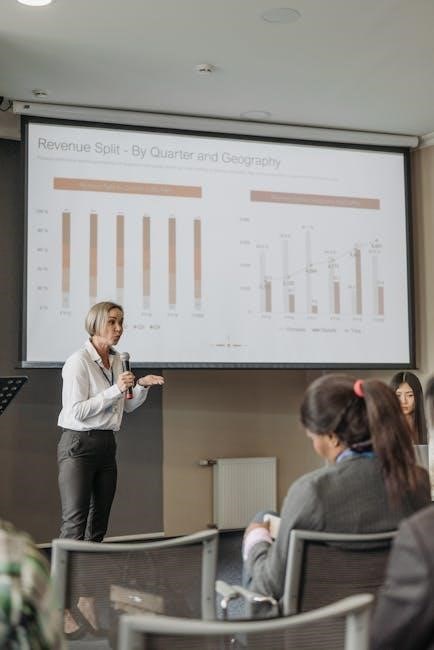The Manga Guide to Statistics offers an innovative approach to learning statistics through Japanese-style comics, blending entertainment with education to make complex concepts engaging and accessible.
Overview of the Manga Guide Series
The Manga Guide series is a unique collection of educational books that combine manga storytelling with complex STEM topics. Published by No Starch Press in the U.S. and Ohmsha in Japan, the series has gained popularity for its engaging and accessible approach to learning. Each book uses Japanese-style comics to explain subjects like statistics, biochemistry, and relativity, making them fun and easy to understand. The series has become a hit globally, offering a fresh alternative to traditional textbooks for students and hobbyists alike.
The Unique Approach of Combining Manga and Statistics
The Manga Guide to Statistics stands out by merging manga, a popular Japanese comic style, with statistical concepts. This engaging format makes learning statistics enjoyable and relatable, especially for visual learners. The story follows Rui, a high school girl, as she navigates statistical principles through real-life scenarios, such as analyzing ramen prices and bowling games. This unique blend of entertainment and education ensures that readers grasp complex ideas effortlessly, making the subject more approachable and fun than traditional textbooks.
Key Concepts Taught in The Manga Guide to Statistics
- Data Types: Categorical vs. numerical data exploration.
- Descriptive Statistics: Mean, variance, and standard deviation explained.
- Probability: Basics of probability density functions.
- Distributions: Key statistical distributions like normal and binomial.
- Hypothesis Testing: Applications and interpretation.
- Regression Analysis: Understanding variable relationships.
Data Types: Categorical vs. Numerical
The manga guide explains data types, distinguishing between categorical and numerical data. Categorical data is non-numerical, such as colors, genders, or food preferences, often used for grouping. Numerical data, like test scores or ramen prices, can be measured and calculated. The guide uses relatable examples, such as teen magazine quizzes or bowling games, to illustrate these concepts. Understanding the difference is crucial for organizing and analyzing data effectively in statistical studies. This foundational knowledge is presented in an engaging, easy-to-understand format.
Descriptive Statistics: Mean, Variance, and Standard Deviation
The Manga Guide to Statistics simplifies descriptive statistics through engaging storytelling. The mean is introduced as the average value, demonstrated with relatable examples like calculating average ramen noodle prices. Variance measures data spread, while standard deviation simplifies it by taking the square root. These concepts are illustrated with real-world scenarios, making them easy to grasp. The guide ensures readers understand these foundational metrics before progressing to more advanced topics, fostering a solid statistical knowledge base through an entertaining narrative approach.
Probability and Probability Density Functions
The Manga Guide to Statistics introduces probability through relatable scenarios, such as rolling dice or analyzing test scores. The guide explains how probability measures the likelihood of events, using manga characters to make abstract concepts engaging. Probability density functions are also covered, illustrating how they describe the distribution of continuous data. By connecting these ideas to real-world examples, like bowling games or ramen noodle prices, the guide makes understanding probability and its applications intuitive and fun, ensuring readers grasp these essential statistical tools.
Important Statistical Distributions
The Manga Guide to Statistics explores key distributions, starting with the normal distribution, often visualized as a bell curve. It explains how data like exam scores or bowling games can follow this pattern. The guide also introduces other distributions, such as binomial and chi-square, using manga-style visuals to simplify complex concepts. By connecting these distributions to real-world examples, the book helps readers understand their practical applications in analyzing and interpreting data effectively, making statistical theory more approachable and memorable.
Hypothesis Testing and Its Applications
The Manga Guide to Statistics simplifies hypothesis testing, a cornerstone of statistical analysis, by presenting it through engaging manga visuals. The guide explains how to formulate null and alternative hypotheses, calculate test statistics, and interpret p-values. Using relatable scenarios, such as analyzing bowling game performance or testing differences in ramen noodle prices, the book demonstrates how hypothesis testing applies to real-world problems. Rui’s journey with Mr. Yamamoto illustrates how this concept helps make informed decisions from data, making complex ideas accessible and fun for learners of all levels. This approach ensures readers grasp the practical significance of hypothesis testing in statistics.
Regression Analysis: Understanding Relationships Between Variables
The Manga Guide to Statistics introduces regression analysis through Rui’s engaging storyline, where she learns to model relationships between variables. The guide explains simple and multiple regression, showcasing how to estimate coefficients and predict outcomes. Using examples like the relationship between study hours and test scores, the manga illustrates how regression helps identify trends and make predictions. Mr. Yamamoto’s clear explanations and visual aids make this complex topic intuitive, allowing readers to apply regression analysis confidently to real-world data and scenarios. This chapter equips learners with essential tools for understanding variable interactions.

The Storyline and Characters
The Manga Guide to Statistics delves into regression analysis, a method for understanding how variables relate. Rui learns to model relationships using simple and multiple regression, estimating coefficients to predict outcomes. Real-world examples, like analyzing study hours vs. test scores, demonstrate how regression identifies trends and makes predictions. Mr. Yamamoto’s patient explanations and visual aids simplify complex concepts, enabling readers to apply regression analysis effectively in various scenarios, from academic to professional settings, making this statistical tool both accessible and practical for everyday use. This chapter is essential for grasping variable interactions and predictive modeling;
Meet Rui: The Heroine’s Journey into Statistics
Rui, the determined heroine, embarks on a statistical adventure to impress her crush, Mr. Igarashi. With the help of her patient tutor, Mr. Yamamoto, she learns the fundamentals of statistics, transforming her initial reluctance into a deep understanding. Through relatable scenarios, Rui discovers how statistics applies to real life, from analyzing test scores to understanding probability. Her journey is both educational and heartwarming, showing how overcoming challenges can lead to personal growth and confidence in mastering complex subjects like statistics.
Mr. Yamamoto: The Patient Tutor
Mr. Yamamoto, Rui’s dedicated tutor, plays a pivotal role in her statistical journey. His patience and expertise make complex concepts like data types, probability, and hypothesis testing accessible. Through his guidance, Rui progresses from confusion to confidence, mastering each topic with his support. Mr. Yamamoto’s teaching style, blending humor and clarity, ensures that Rui not only learns statistics but also develops a genuine interest in the subject, making him an indispensable mentor in her educational adventure.
Mr. Igarashi: The Motivation Behind Rui’s Statistical Quest
Mr. Igarashi is the catalyst for Rui’s journey into statistics. Her admiration for him drives her to pursue this field, transforming a daunting subject into an exciting challenge. Through her efforts to impress him, Rui discovers the practical applications of statistics, making her learning experience both meaningful and enjoyable. Mr. Igarashi’s influence not only motivates Rui but also highlights how personal goals can fuel academic pursuits, creating a relatable and inspiring narrative for readers.

What Makes The Manga Guide to Statistics Unique
Its innovative blend of manga storytelling and statistical education creates an engaging, accessible learning experience, making complex concepts fun and memorable for readers of all ages.
The EduManga Format: A Hit in Japan
The EduManga format, developed in Japan, combines engaging manga storytelling with educational content to make complex topics like statistics approachable and entertaining. By integrating detailed explanations with relatable characters and real-world examples, such as ramen noodle prices and bowling games, it creates a unique learning experience. This innovative approach has gained significant popularity in Japan and beyond, proving that education can be both fun and effective. Its success has led to translations and adaptations worldwide, making it a groundbreaking tool for STEM education.
Real-World Examples: From Ramen Noodle Prices to Bowling Games
The Manga Guide to Statistics uses everyday scenarios, such as analyzing ramen noodle prices and understanding bowling game outcomes, to explain complex statistical concepts. These relatable examples help readers connect abstract ideas to real-life situations, making learning more intuitive and enjoyable. By grounding statistics in familiar contexts, the guide ensures that readers can apply their newfound knowledge to practical problems, enhancing both understanding and retention of the material.

The Structure of the Book
The Manga Guide to Statistics is structured into seven chapters, each combining engaging cartoons, detailed explanations, exercises, and summaries for comprehensive learning and retention.
Chapter Breakdown: Cartoons, Text, Exercises, and Summaries
The Manga Guide to Statistics is divided into seven chapters, each following a consistent structure. Engaging manga cartoons introduce concepts visually, while accompanying text provides detailed explanations. Practical exercises allow readers to apply what they’ve learned, with answers included for self-assessment. Summaries at the end of each chapter reinforce key points, ensuring a thorough understanding of statistics. This balanced format makes complex topics accessible and fun, catering to different learning styles and promoting effective retention of knowledge.

Target Audience
The Manga Guide to Statistics is designed for students, professionals, and hobbyists seeking an engaging way to learn statistics. Its unique format appeals to diverse learners.
Students, Professionals, and Hobbyists: Who Can Benefit
The Manga Guide to Statistics is ideal for students seeking an engaging alternative to traditional textbooks, professionals needing a refresher on key concepts, and hobbyists curious about data analysis. Its accessible format makes complex ideas enjoyable for learners at all levels. The combination of manga storytelling and real-world examples ensures that anyone, regardless of their background, can grasp statistical fundamentals. This unique approach bridges education and entertainment, making it a versatile resource for a broad audience.
The Manga Guide Series: A Broader Perspective
The Manga Guide Series is a popular collection of educational books that uses manga to explain complex STEM topics. Published by Ohmsha in Japan and No Starch Press in the U.S., the series covers subjects like statistics, biochemistry, relativity, and more, making learning fun and accessible for a global audience.
Other Titles in the Series: From Biochemistry to Relativity
The Manga Guide Series extends beyond statistics, offering engaging STEM titles. The Manga Guide to Biochemistry and The Manga Guide to Relativity are popular examples, blending comics with complex topics like molecular biology and theoretical physics. These books, published by Ohmsha in Japan and No Starch Press in the U.S., cater to diverse interests, making learning fun for students and enthusiasts alike. The series ensures that challenging subjects are accessible through an entertaining, visual approach, fostering education worldwide.

Impact and Reception
The Manga Guide to Statistics has received positive reviews for its unique approach, making it a must-read for learners seeking an engaging statistics resource. Its success has inspired future editions.
Reader Reviews and Testimonials
Readers worldwide have praised The Manga Guide to Statistics for its engaging and accessible approach. Many highlight how the manga format makes complex concepts fun and easy to grasp. Testimonials often mention the relatable storyline and how it simplifies statistics for beginners. Fans appreciate the real-world examples, such as ramen noodle prices and bowling games, which make learning practical and enjoyable. The patience of Mr. Yamamoto and Rui’s determination are frequently praised, inspiring readers to master statistics. Overall, the book has received glowing reviews for its unique blend of education and entertainment.
The Manga Guide to Statistics truly simplifies complex concepts with engaging manga, making it an essential and popular resource for learners of all levels.
Why The Manga Guide to Statistics is a Must-Read
The Manga Guide to Statistics is a must-read for anyone seeking an engaging and accessible introduction to statistics. By blending Japanese-style comics with educational content, it transforms a traditionally dry subject into an enjoyable learning experience. The story follows Rui, a determined heroine, as she navigates statistical concepts with the help of her tutor, Mr. Yamamoto. This unique format makes complex ideas like data types, probability, and hypothesis testing easy to understand and relatable. Its innovative approach ensures that readers of all levels, from students to professionals, can grasp essential statistical principles while staying entertained, making it a standout resource in the field.
Future Editions and Expansions in the Series
The Manga Guide series continues to expand, with plans for new editions and topics that build on its successful formula. Future releases may include advanced statistics, specialized techniques, and emerging fields like data science. The series’ popularity in Japan and internationally ensures ongoing development, with potential digital enhancements such as interactive exercises or animations. By maintaining its unique blend of education and entertainment, the Manga Guide series promises to remain a leader in making complex subjects accessible and engaging for learners worldwide.
